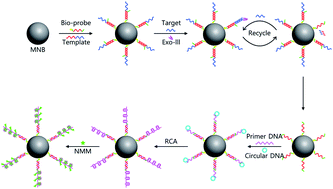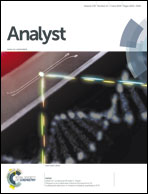A cascade signal amplification strategy for sensitive and label-free DNA detection based on Exo III-catalyzed recycling coupled with rolling circle amplification†
Abstract
A sensitive and label-free fluorescence assay for DNA detection has been developed based on cascade signal amplification combining exonuclease III (Exo III)-catalyzed recycling with rolling circle amplification. In this assay, probe DNA hybridized with template DNA was coupled onto magnetic nanoparticles to prepare a magnetic bead-probe (MNB-probe)–template complex. The complex could hybridize with the target DNA, which transformed the protruding 3′ terminus of template DNA into a blunt end. Exo III could then digest template DNA, liberating the MNB-probe and target DNA. The intact target DNA then hybridized with other templates and released more MNB-probes. The liberated MNB-probe captured the primer, circular DNA and then initiated the rolling circle amplification (RCA) reaction, realizing a cascade signal amplification. Using this cascade amplification strategy, a sensitive DNA detection method was developed which was superior to many existing Exo III-based signal amplification methods. Moreover, N-methyl mesoporphyrin IX, which had a pronounced structural selectivity for the G-quadruplex, was used to combine with the G-quadruplex RCA products and generate a fluorescence signal, avoiding the need for any fluorophore-label probes. The spike and recovery experiments in a human serum sample indicated that our assay also had great potential for DNA detection in real biological samples.


 Please wait while we load your content...
Please wait while we load your content...